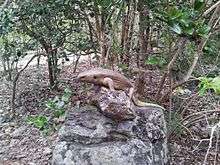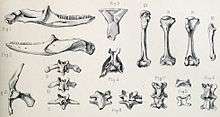Mauritian giant skink
Leiolopisma mauritiana, Didosaurus maurtianus, is a large (the largest known), extinct species of skink (family Scincidae). It was found only in Mauritius, but became extinct around 1600 probably due to introduced predators.

| Leiolopisma mauritiana | |
|---|---|
 | |
| Fossils | |
| Scientific classification | |
| Kingdom: | Animalia |
| Phylum: | Chordata |
| Class: | Reptilia |
| Order: | Squamata |
| Family: | Scincidae |
| Genus: | Leiolopisma |
| Species: | †L. mauritiana |
| Binomial name | |
| †Leiolopisma mauritiana (Günther, 1877) | |
| Synonyms | |
|
Didosaurus mauritianus | |
It may have been somewhat fossorial in nature. This is speculative and based on a reconstruction. The Mauritian giant skink, became extinct by 1650. Only a semi - complete specimen is known in addition to some odd bones. (Supposedly, a former director of the Mauritian Institute threw away specimens including some bones of this species). The remaining skeleton is missing the feet and digits, thus making it impossible for a SENI biometric analysis per se (Schnirel. 2004). The semi - complete skeleton does have a skull shaped similar to a blue-tongue skink (Genus: Tiliqua). The restoration undertaken by the (Species in Bronze Project), if accurate, gives a SENI value of .06 which would indicate that this species could have been fossorial or saxicolous in lifestyle. This is further linked by the fact that the closest living relative of this species (as mentioned by the restorers) is the Round Island skink: Leiolopisma telfeirii. The Round Island skink also gives a SENI value of .06. The Round Island skink is a species capable of caudal autotomy. This skink is often seen darting in the underbrush or between rocks.
An undescribed extinct Leiolopisma from Réunion was closely related, whereas the Round Island skink is a more distantly related surviving species from Mauritius. (Austin & Arnold 2006)
Behavior
The behavior of this animal is not well known or documented by any travelers to Mauritius when it was extant, however many things such as its diet and other aspects of its behavior can most likely be determined by extant skink species. It is very likely that the Mauritian Giant Skink shared behavioral traits with many other ground based skinks such as the Blue Tongued Skink such as its diet and its overall temperament and speed. The Mauritian Giant Skink was most likely an opportunistic omnivore that fed on anything from small invertebrates, small lizards and even fruits and plants. Its temperament was most likely very similar to that of modern ground skinks and was most likely a very tame animal that had relatively no fear of humans which might have played a part in its extinction.
References
- Austin, J.J. & Arnold, E.N. (2006): Using ancient and recent DNA to explore relationships of extinct and endangered Leiolopisma skinks (Reptilia: Scincidae) in the Mascarene islands. Molecular Phylogenetics and Evolution 39(2): 503–511. doi:10.1016/j.ympev.2005.12.011 (HTML abstract)
- Concerning the World Conservation Monitoring Centre (1996). "Leiolopisma mauritiana". The IUCN Red List of Threatened Species. IUCN. 1996: e.T11410A3277412. doi:10.2305/IUCN.UK.1996.RLTS.T11410A3277412.en. Retrieved 9 January 2018. Database entry includes justification for why this species is extinct.
- Schnirel, Brian L.; (2004). Seni biometric analysis on the extinct Scincidae species: Macroscincus coctei. Polyphemos, Volume 2, Issue 1, May, Florence, South Carolina, U.S.A. pp. 12–22.
| Wikimedia Commons has media related to Leiolopisma mauritiana. |
External links
- Painting of L. mauritiana and red rail by Julian Hume.
- www.extinct-species.com Bones to Bronze - Extinct species of the Mascarene Islands. Gallery Pangolin, London.
